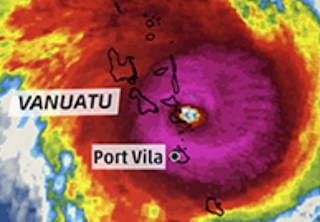The island is the smallest in the Malampa province being only 8 km
from north to south and 5 km or so at its widest point and is dominated by
hills, rising to a height of around 550 m.
It is also surrounded by the active Ambrym and Lopevi volcanoes to the north and east as well as the larger Epi to the south.
 |
| Note the abrupt ends to the runway! |
Wikipedia warned me that “landing and taking off from this grass airstrip at the north of the island is not for the faint-hearted” as it is one of the shortest airstrips in the whole of Vanuatu with the ocean at one end and a ‘bigfala’ hill on the other!
The majority of the approx.1,600 people living on Paama live in villages close to the coast of the island and make their gardens on the hillsides nearby.
Our task was to work with villages around the island wishing to develop
their tourism opportunities. No resort chains here! This is a few village based,
basic guest houses and the beginnings of some associated cultural and outdoor activities
where the majority of any benefits should go back the locals. (with the
exception of VAT tax and business licence fees which the government happily
grabs L)
The island currently has very low visitor numbers with flights available
only 2 days a week - so most suitable for the intrepid traveler wanting to get away
from the bright lights of Villa or Luganville.
Some of the potential activities under consideration include a Paama custom
experience, a walk to view the nearby and spectacular Lopevi volcano, (as well
as an epic Lopevi summit expedition) and fishing both the traditional outrigger
canoe form as well as the aluminum boat/outboard motor variety….
Our ‘taster’ for the Paama custom experience included traditional string games,
impressive sand drawing, basket and mat making with coconut and pandanus fronds
respectively…and a climb up to one of the inland villages for a feed of laplap
(yam with a meat filling, covered in coconut milk and wrapped in island
cabbage) and a finale of custom dance.......
The Lopevi view walk provided a brief village experience, including an explanation about the use and protocols with the Nakamal (meeting house) within the village, as well as the spectacular view out to the Lopevi volcano itself.

For any Gilbert and Sullivan fans out there, Lopevi has a vague resemblance to the island of Bali Hai from the musical South Pacific.
Although previously occupied, as a result of damage from volcanic
eruptions, villages have now moved to nearby Epi or elsewhere.
Plans are currently being discussed for a
return to experience the summit climb....
As well as being susceptible to cyclones, earthquakes and tsunamis as with
elsewhere in Vanuatu, Paama is also regularly affected by volcanic ash from
nearby islands damaging crops, contaminating water supplies and inshore
fisheries for periods of time. It’s relatively poor soils also the limit crops
that are able to be grown and following rainfall events also slip readily
blocking access routes between villages and to the few public facilities that
exist on the island.
‘Paamese’ people are therefore very resilient and despite these challenges, as with elsewhere in
Vanuatu, extremely warm and welcoming to any ‘white man’ that might choose to
visit.
A small amount of village based tourism has the potential to provide
some modest, but important, cashflow for these communities to assist in getting
their children through school, developing more cyclone resistant housing.,
improving hygiene and water supplies etc.
As well as limitations with access and natural disasters such as Cyclone
Pam last year, national governance and important public infrastructure
maintenance issues also have flow on effects to the wider Nivan community. A prime example at present is the ongoing runway issue at Port Vila which continues to
seriously affect recovery of the tourism sector with news this week that Virgin
Australia have again pulled out of flights in and out of Vila rejoining Air New Zealand……....







No comments:
Post a Comment